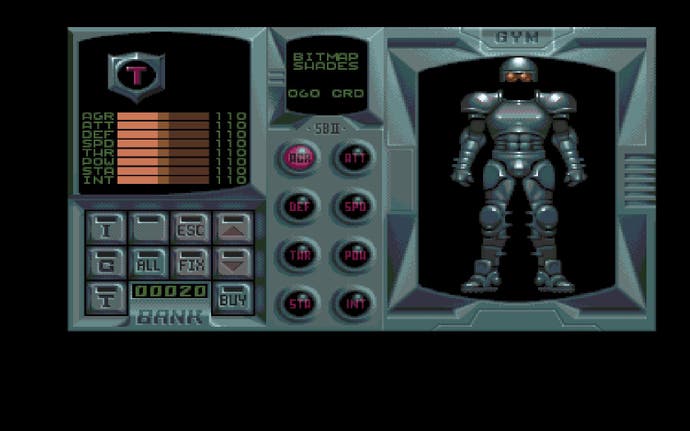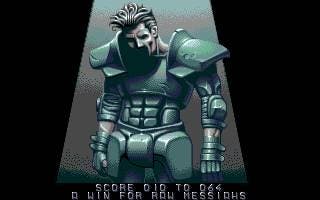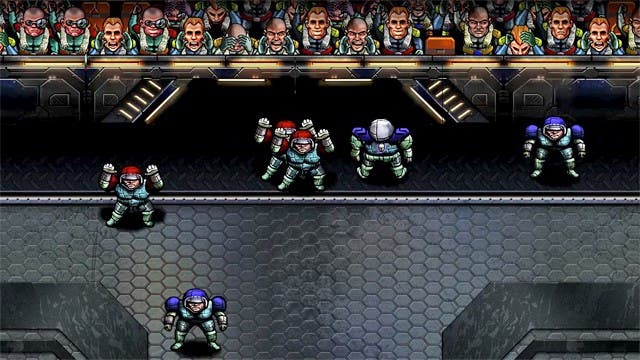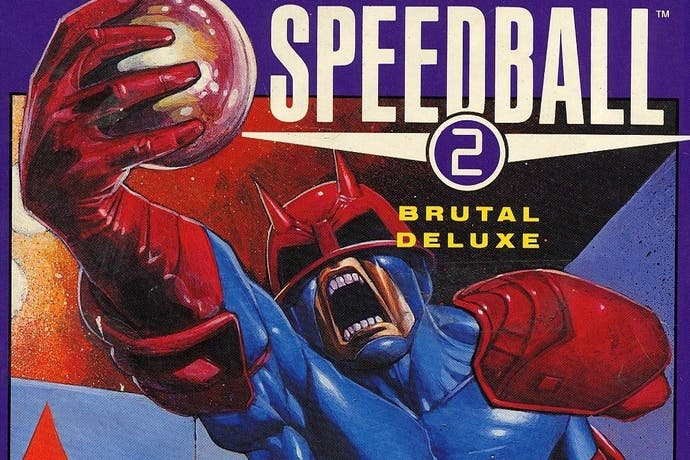Wish I was a baller: The making of Speedball 2
How indoor tennis and pinball combined to create a classic that's still unbeaten.
The shot flies high and straight, arcing towards the overhead camera as the players below jostle for position. Nobody is close enough to intercept. The last line of defence is the keeper, and he's right there, in the narrow mouth of the goal, too smart to stray off his line. He takes it easily. A split-second later, the opposition forward slams into him, taking the ball out of his limp hands, finishing the play. The scoreboard shows ten - and then an instant later, another ten. The keeper, it turns out, is still on the floor, waiting for the medical droids that will come and scoop him off the field of play. His legs twitch, briefly. Somewhere in the stands, a voice calls out, almost too faint to hear. 'Ice cream?'
NBA Jam may pale before the 2K series, Madden improves almost every year, and even the mighty Sensible Soccer looks limited next to modern-day Pro Evo, but in the future-sports genre there's still barely a game fit to polish Speedball 2's shiny metal boots. Alone among the 90s sports games, it's never really been outclassed in its own field, even by its own creators. Speedball 2 HD, the version currently selling on Steam, is essentially a remake with a few more colours and league options - no 3D, no real-time pitch deformation, no microtransations to buy better helmets or spiky balls. Speedball 2, almost alone among games, seems to have defied the ageing process.

One thing that helps, of course, is that Speedball isn't a real game, and so everything's designed to fit the limitations of the top-down, 2D format. Things were nearly very different, and much more boring. "The first Speedball was an interesting story," says Mike Montogomery, lead Bitmap Brother and designer on the game. "We'd just finished Xenon on the Master System for Mastertronic, and they said 'Look, we've got this idea about doing a game based on real tennis.'" That would be the forebear of modern tennis, played on indoor courts where you can bounce the balls off the walls. The one that nobody plays.
"Yeah, exactly," says Montgomery. "There's about one court in the country, Prince Charles plays it. So anyway, we spent quite a while working on designs and then Mastertronic went, 'We've changed our minds,' so then we were quite depressed and went down the pub. But after a few beers we went, look, maybe we can make something out of this. We didn't have any paper at the time, so we wrote the design on the back of a fag packet. A few weeks later on we sold the game design to Mirrorsoft and that was part of the documentation. Then they went bust, so I don't know where that fag packet is now. It'd probably be worth a bit."
"We had a few beers and went, look, maybe we can make something out of this. We didn't have any paper at the time, so we wrote the design on the back of a fag packet."

The moderately well-received original, released in 1988, was basically just a violent version of handball, with one goal, five players and a fledgling version of the metallic graphics that would eventually become a Bitmap Brothers signature. The sequel added four more players per side to the mix, alongside a flurry of new scoring options, including points multipliers, ball-electrifiers, collect-the-set scoring stars and the all-important warp tunnel. Suddenly, the tactics possible exploded out from 'pass and shoot' like a fractal diagram. You can, for instance, wrong-foot the keeper by slinging the ball through a teleport tunnel along the right diagonal, or angle a shot off the bounce dome so that it sneaks in over his head. It looks, you'd have to say, a lot like pinball.
"Yeah, exactly. I don't think anyone's asked me that before, but that was what it was based on. People mention [ultra-violent James Caan classic] Rollerball, but I can't remember any Rollerball influence whatsoever. I know Rollerball was around at the time, but to be quite honest it was a coincidence more than an influence. Most of it was trying to get that arcade scoring system right. Definitely pinball." And what about Kick-Off 2, the ruler of the top-down boot-abouts in the pre-Sensible Soccer days? "Kick Off 2 had an influence," says Montgomery. "But Sensi had more of an influence. I'd been a fan of Sensible Software for donkey's years, so we saw it in development at some point."
Of course, more violent tactics are possible too. In Speedball 2 there are points for administering a beating so severe it requires a substitution, and injuring more than three players forces one of them to stay on the field, dragging himself around at half-speed. The game's less refined tactics include 'stand over the player in the corner, hitting him', and 'throw it to the opposition keeper, then charge in behind the ball.' The satisfying violence of the tackles is a huge part of the appeal, but despite the audible crunches, there's remarkably little actual gore, certainly compared to contemporaries like Brutal Sports Football.
"We wanted people to be quite violent," says Montgomery. "I don't think there's any blood, but there's this point of leaving it to the player to think that it's violent. Put it this way, it would never be banned in Germany."

Then, of course, there are the incidental touches which stick in the memory. As with many of the 16-bit era's most famed gameplay elements, Speedball 2's most famous sound effect - that ice cream guy - was originally brought in as a solution to technical limitations elsewhere.
"In those days doing crowds was quite hard, because of the memory constraints," says Montgomery. "You'd get these patterns in the sound that were quite annoying. So by adding in these random elements like the ice cream guy and the klaxon, you'd break it up. The guy that worked on it was called Richard Joseph, he's sadly not with us any more, but he did the 'Ice cream!' shout and I remember, he came into the office and went 'Tell me what you honestly think', and I went 'Wow, that's incredible. That's going to make it fly.' And it really did. It's so memorable!"
So why, in all the iterations since - from Playstation's Speedball 2100 to the lamentable Speedball 2 Tournament - has nobody managed to better the original? "I think the problem has always been that the gameplay was designed for 2D," says Montgomery. "3D just doesn't quite work. It's supposed to be fast and furious - you end up with a different game just to make it work, and that's not really the intention. The amount of balancing and gameplay in the original was just tremendous. It'd be like, play it, does it work, play it again, balance it, until it works. It even works like real football, in that you play a cup game differently to a league game. What we've done with HD is just building on that."
Like the saying goes - if it ain't broke, don't fix it. Unless 'it' is an opposition player, in which case break it, and then break the substitute that's brought on in its place. Speedball 2: don't ever change.
